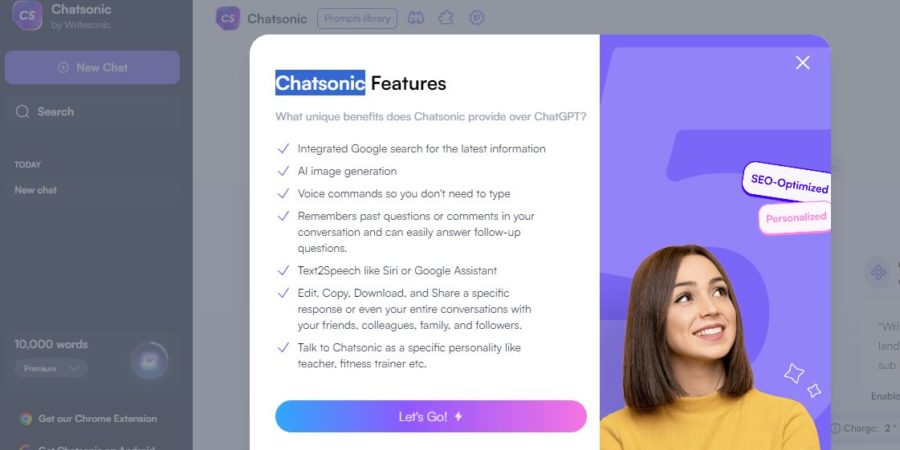In recent years, the field of artificial intelligence (AI) has witnessed remarkable advancements, especially in the domain of natural language processing. OpenAI’s GPT-3, with its powerful language generation capabilities, has been a prominent player in this arena. However, it’s not the sole contender. Several alternatives have emerged, each offering unique features and capabilities. In this article, we will delve into five notable alternatives: Chatsonic, OpenAI Playground, Claude, Bard AI, and Jasper Chat. This is an Article about Exploring 5 Alternatives to ChatGPT
1. Chatsonic (Writesonic): Chatsonic, formerly known as Writesonic, is an AI-powered writing platform designed to assist content creators in generating high-quality written content. Its main focus lies in creating blog posts, marketing copy, product descriptions, and more. Chatsonic utilizes AI to produce coherent and contextually appropriate text based on user-provided prompts. What sets Chatsonic apart is its user-friendly interface, which simplifies the content creation process. It offers a range of writing templates tailored to various niches, enabling users to customize their output effectively.
2. OpenAI Playground: OpenAI Playground provides developers and researchers with an interactive platform to experiment with OpenAI’s language models, including GPT-3. While not a full-fledged alternative to ChatGPT for end-users, it serves as a valuable tool for those interested in exploring the capabilities of GPT-3 and testing various prompts. The Playground offers a sandbox environment where users can fine-tune prompts and observe model responses in real-time. This makes it an essential resource for refining prompts and understanding how to interact more effectively with GPT-3.
3. Claude: Claude steps into the chatbot arena with a unique focus on creating interactive and engaging virtual characters. It aims to provide a platform for developers to design and deploy AI-driven characters for applications such as gaming, virtual storytelling, and customer service. Claude boasts a character-centric approach, allowing developers to customize the personality, traits, and behavior of their virtual creations. By concentrating on character interactions, Claude opens up new avenues for dynamic and immersive experiences beyond traditional chat interfaces.
4. Bard AI: Bard AI specializes in generating creative and artistic content. Unlike some other alternatives that prioritize a wide range of writing tasks, Bard AI centers its efforts on assisting users in crafting poetry, stories, and other creative pieces. It taps into AI’s potential for ideation and can serve as a valuable co-creator for writers seeking inspiration. Bard AI’s algorithms analyze the user’s input and provide suggestions, helping to overcome writer’s block and fostering artistic expression.
5. Jasper Chat: Jasper Chat enters the scene with a strong emphasis on providing AI-powered customer support solutions. It’s designed to enhance user engagement and streamline customer interactions on websites and messaging platforms. Jasper Chat leverages AI to understand customer inquiries, provide relevant information, and even perform tasks like order tracking and appointment scheduling. By automating these processes, businesses can improve customer satisfaction while reducing the workload on their support teams.
In conclusion, the landscape of AI-powered language generation is thriving with innovation, and these alternatives to ChatGPT showcase the diverse applications of this technology. Chatsonic focuses on content creation with its user-friendly templates, while the OpenAI Playground offers a testing ground for developers to fine-tune their interactions with GPT-3. Claude introduces the concept of AI-driven virtual characters for interactive experiences, and Bard AI fosters creativity in the realm of poetry and storytelling. On the business front, Jasper Chat stands out by enhancing customer support through AI-driven interactions.
As AI technology continues to evolve, these alternatives exemplify the adaptability and versatility that AI-powered language models bring to various domains. Depending on specific needs and objectives, developers, content creators, businesses, and artists can explore these alternatives to find the perfect match for their requirements. Whether it’s crafting compelling content, experimenting with AI interactions, creating immersive virtual characters, nurturing creativity, or optimizing customer support, these alternatives offer a glimpse into the expanding horizons of AI-driven language capabilities.
You May Also Like –Generative AI Enhances Jobs Positively


